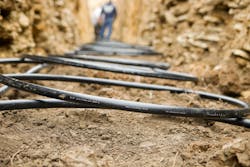DOE Study Highlights Geothermal Energy’s Potential
The U.S. Department of Energy released analysis detailing how the United States can benefit from the vast potential of geothermal energy. The report, GeoVision: Harnessing the Heat Beneath Our Feet, found that geothermal electricity generation could increase more than 26-fold from today—reaching 60 gigawatts (GW) of installed capacity by 2050.
In addition to describing electricity-generation opportunities, the GeoVision analysis also highlights geothermal’s advantages for heating and cooling solutions through direct-use and heat-pump technologies. The report assessed opportunities to expand nationwide geothermal energy deployment by improving technologies, reducing costs, and addressing project development barriers such as long permitting timelines.
Under current plans, geothermal generation capacity will grow to 6 GW by 2050, the report said. That rate could be doubled by accelerating development timelines and increased further by combining faster development timelines with technology improvements, the study said.
The analysis also looked at prospects for geothermal district heating, examined economic benefits to the U.S. geothermal industry; investigated opportunities for desalination, mineral recovery, and hybridization with other energy technologies for greater efficiencies and lower costs; and quantified potential environmental impacts of increased geothermal deployment.
